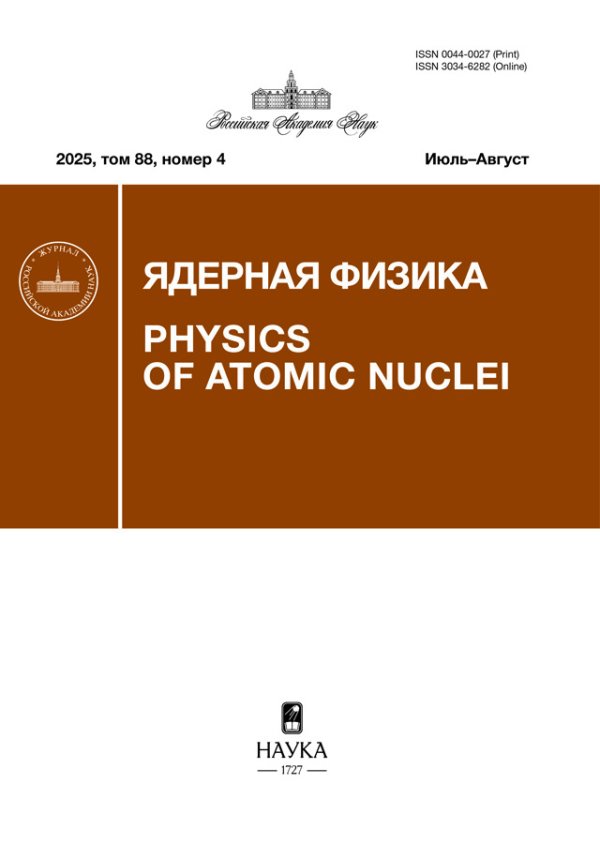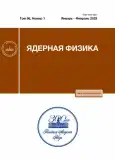Theoretical Approaches Making It Possible to Describe Simultaneously P-Even T-Odd Asymmetries in Nuclear-Fission Processes Induced by Polarized Neutrons and Accompanied by the Emission of Various Light Particles
- Authors: Kadmensky S.G.1, Lyubashevsky D.E.1
-
Affiliations:
- Voronezh State University
- Issue: Vol 86, No 1 (2023)
- Pages: 142-154
- Section: МАТЕРИАЛЫ LXXII МЕЖДУНАРОДНОЙ КОНФЕРЕНЦИИ “ЯДРО-2022: ФУНДАМЕНТАЛЬНЫЕ ВОПРОСЫ И ПРИЛОЖЕНИЯ”. Ядра. Теория
- Published: 01.03.2023
- URL: https://rjsvd.com/0044-0027/article/view/674755
- DOI: https://doi.org/10.31857/S0044002723010221
- EDN: https://elibrary.ru/RBUMJV
- ID: 674755
Cite item
Abstract
In a special laboratory frame, the differential cross sections
for the fission of nonoriented target nuclei that is induced by cold polarized neutrons
and which is accompanied by the emission of light particles
, such as prescission alpha particles or prompt neutrons
, and photons can be represented as the sum of two terms. The first term is equal to the cross section for the analogous reaction induced by unpolarized neutrons,
, where
is the total cross section for this reaction and
is the angular distribution of light particles
emitted in this reaction. The second term in this sum,
, depends linearly on the neutron polarization vector
and describes
-even
-odd asymmetries in the original cross section. By employing the concepts of space isotropy and parity conservation, it is possible to represent the cross section
as the sum of two scalar functions,
, which are related to the correlation functions (
) and (
)(
) that are, correspondingly, even and odd under the transformation
, where
and
are the wave vectors of the light fission fragment and the light particle, respectively. These correlation functions can be expressed in terms of the quantities
, whose experimental values can be found from the experimental values of the asymmetry coefficient
introduced earlier [1] and the angular distribution
of light particles by employing the relation
. Within the quantum-mechanical approach, the theoretical values of
can be obtained by means of the formula
, which takes into account the angle
of rotation of the light-particle wave vector
about the wave vector
of the light fission fragment under the effect of Coriolis interaction associated with the collective rotation of the fissioning system about the axis orthogonal to its symmetry axis. The angle of rotation is determined from a comparison of the experimental and theoretical values of
with the aid of the maximum-likelihood method. Because of taking into account quantum interference effects,
may in general take not only positive (as is the case within the semiclassical method of trajectory calculations [1]) but also negative values. The use of this result permits reaching reasonable agreement between the experimental and theoretical values of
for all
particles simultaneously in the cases of
U,
Pu, and
Pu target nuclei. In the case of the
U target nucleus, however, the quantity
, which is independent of the angle
, should be supplemented with
in order to reach the same degree of agreement. The appearance of the latter may in principle be due [1] to the violation of axial symmetry of the fissioning system because of the effect of its bending and wriggling vibrations in the vicinity of the scission point.
About the authors
S. G. Kadmensky
Voronezh State University
Email: kadmensky@phys.vsu.ru
Voronezh, Russia
D. E. Lyubashevsky
Voronezh State University
Author for correspondence.
Email: kadmensky@phys.vsu.ru
Voronezh, Russia
References
- С. Г. Кадменский, Л. В. Титова, В. Е. Бунаков, ЯФ 82, 239 (2019) [Phys. At. Nucl. 82, 254 (2019)].
- P. Jesinger, G. V. Danilyan, A. M. Gagarski, P. Geltenbort, F. Gönnenwein, A. Kötzle, Ye. I. Ko- robkina, M. Mutterer, V. Nesvizhevsky, S. R. Neu- maier, V. S. Pavlov, G. A. Petrov, V. I. Petrova, K. Schmidt, V. B. Shvachkin, and O. Zimmer, ЯФ 62, 1723 (1999) [Phys. At. Nucl. 62, 1608 (1999)].
- P. Jessinger, A. Kötzle, F. Gönnenwein, M. Mutterer, J. von Kalben, G. V. Danilyan, V. S. Pavlov, G. A. Petrov, A. M. Gagarski, W. H. Trzaska, S. M. Soloviev, V. V. Nesvizhevski, and O. Zimmer, Phys. At. Nucl. 65, 630 (2002).
- A. Gagarski, F. Gönnenwein, I. Guseva, P. Jesinger, Yu. Kopatch, T. Kuzmina, E. Lelièvre-Berna, M. Mutterer, V. Nesvizhevsky, G. Petrov, T. Soldner, G. Tiourine, W. H. Trzaska, and T. Zavarukhina, Phys. Rev. C 93, 054619 (2016).
- G. V. Danilyan, P. Granz, V. A. Krakhotin, F. Mezei, V. V. Novitsky, V. S. Pavlov, M. Russina, P. B. Sha- talov, and T. Wilpert, Phys. Lett. В 679, 25 (2009).
- Г. В. Данилян, Й. Кленке, Ю. Н. Копач, В. А. Кра- хотин, В. В. Новицкий, В. С. Павлов, П. Б. Шаталов, ЯФ 77, 715 (2014) [Phys. At. Nucl. 77, 677 (2014)].
- Г. В. Данилян, ЯФ 82, 235 (2019) [Phys. At. Nucl. 82, 250 (2019)].
- A. M. Gagarski et al., Crystallogr. Rep. 56, 1238 (2011).
- A. Bohr and B. Mottelson, Nuclear Structure (Benjamin, New York, 1975), Vol. 2.
- О. П. Сушков, В. В. Фламбаум, УФН 136, 3 (1982) [Sov. Phys. Usp. 25, 1 (1982)].
- А. С. Давыдов, Теория атомного ядра (Наука, Москва, 1958).
- С. Г. Кадменский, ЯФ 65, 1424 (2002) [Phys. At. Nucl. 65, 1390 (2002)].
- С. Г. Кадменский, ЯФ 62, 236 (1999).
- С. Г. Кадменский, ЯФ 68, 2030 (2005) [Phys. At. Nucl. 68, 1968 (2005)].
- С. Г. Кадменский, Л. В. Титова, В. Е. Бунаков, Изв. РАН. Сер. физ. 75, 1033 (2011) [Bull. Russ. Acad. Sci.: Phys. 75, 978 (2011)].
- С. Г. Кадменский, В. Е. Бунаков, Д. Е. Любашевский, Изв. РАН. Сер. физ. 83, 1236 (2019) [Bull. Russ. Acad. Sci.: Phys. 83, 1128 (2019)].
- C. Guet et al., Nucl. Phys. 314, 1 (1979).
- F. Fossati et al., Nucl. Phys. 208, 196 (1973).
- T. Ericson and V. Strutinsky, Nucl. Phys. 8, 284 (1958).
- В. М. Струтинский, ЖЭТФ 37, 861 (1959) [Sov. Phys. JETP 10, 613 (1960)].
- Л. Д. Ландау, Квантовая механика (Физматгиз, Москва, 1978), т. 2.
- С. Г. Кадменский, Д. Е. Любашевский, П. В. Кострюков, ЯФ 82, 252 (2019) [Phys. At. Nucl. 82, 267 (2019)].
- E. P. Wigner, Ann. Math. 62, 548 (1955); 65, 203 (1958); 67, 325 (1958).
- С. Г. Кадменский, В. П. Маркушев, В. И. Фурман, ЯФ 35, 300 (1982) [Sov. J. Nucl. Phys. 35, 166 (1982)].
- С. Г. Кадменский, ЯФ 65, 1833 (2002) [Phys. At. Nucl. 65, 1785 (2002)].
- В. М. Струтинский, ЯФ 3, 614 (1965).
- С. Г. Кадменский, Л. В. Родионова, ЯФ 66, 1259 (2004); ЯФ 68, 1491 (2005) [Phys. At. Nucl. 68, 1433 (2005)].
- J. R. Nix and W. J. Swiatecki, Nucl. Phys. A 71, 1 (1965).
- В. Е. Бунаков, С. Г. Кадменский, Д. Е. Любашевский, ЯФ 79, 198 (2016) [Phys. At. Nucl. 79, 304 (2016)].
- J. B. Wilhelmy, E. Cheifetz, R. C. Jared, S. G. Thom- pson, H. R. Bowman, and J. O. Rasmussen, Phys. Rev. 5, 2041 (1972).
- A. Gavron, Phys. Rev. 13, 2562(R) (1976).
- С. Г. Кадменский, Л. В. Титова, Д. Е. Любашевский, А. С. Веретенников, А. А. Писклюков, ЭЧАЯ 53, 620 (2022) [Phys. Part. Nucl. 53, 644 (2022)].
- Д. Е. Любашевский, Изв. РАН. Сер. физ. 84, 1406 (2020) [Bull. Russ. Acad. Sci.: Phys. 84, 1201 (2020)].
- Л. Яноши, Теория и практика обработки результатов измерений (Мир, Москва, 1968).
- И. Н. Силин, Поиск максимума правдоподобия методом линеаризации. Статистические методы в экспериментальной физике (Атомиздат, Москва, 1976).
Supplementary files











